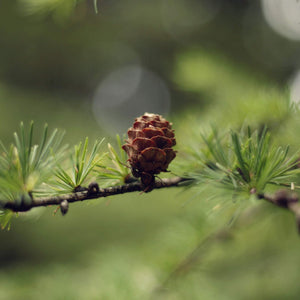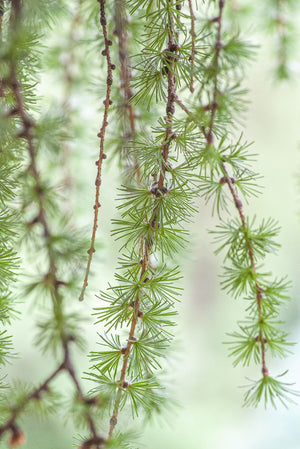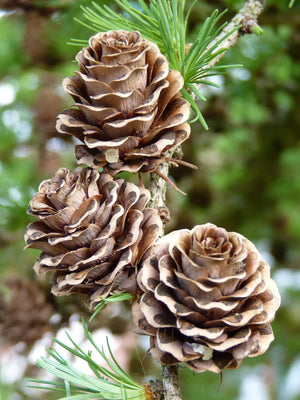The Larch Guide
Larch trees bring a captivating and enduring presence to any natural setting. With their tall, slender forms, unique needle-like foliage, and adaptability, larch trees stand as remarkable additions to a variety of environments. These splendid trees can thrive under diverse conditions with the right care and maintenance. Whether you aspire to create a serene forested haven or are in search of a distinctive highlight for your garden, larch trees are an excellent choice. Their charm and tenacity can enhance your landscape, adding grace and allure for years to come.

About
Larch trees, classified under the Larix genus, encompass several deciduous conifers celebrated for their distinctive characteristics and ecological significance. This diverse group of trees includes multiple species found across the Northern Hemisphere's temperate regions, such as North America, Europe, and Asia. Larch trees are revered for their exceptional features and the pivotal roles they play in supporting local ecosystems.
An outstanding feature of larch trees is their unique needle-like leaves that turn brilliant shades of yellow and orange in the fall, creating a breathtaking display. These trees typically shed their foliage in the winter, a characteristic that distinguishes them from most other conifers. The bark of larch trees often possesses a rugged texture and a reddish-brown hue, adding to their natural beauty.
Larch trees have significant ecological importance, serving as valuable habitats for a wide array of wildlife. Their pollen-rich flowers, which appear in small clusters, support early-season pollinators like bees and other beneficial insects. The seeds of larch trees are encased in small cones, providing a vital food source for numerous birds and mammals.
These versatile trees showcase adaptability to different soil types and environmental conditions. While they thrive in well-drained soil, larch trees can flourish under full sun or partial shade. Their resilience against various climates and moderate growth rate make them an excellent choice for a wide range of landscaping applications.
Whether you utilize them as eye-catching focal points in your garden, employ them in clusters to create windbreaks, or incorporate them into mixed borders, larch trees contribute elegance and charm to any landscape. Prominent species include the European larch (Larix decidua) and the Japanese larch (Larix kaempferi), both celebrated for their aesthetic allure and their role in supporting biodiversity.
By selecting and caring for larch trees within your landscape, you not only enhance the natural beauty of your outdoor space but also play a part in preserving these remarkable trees and the ecosystems they nurture.

Planting
Larch trees, like many other tree species, have specific requirements for planting and maintenance to ensure their optimal growth. Here are some fundamental guidelines for planting and caring for larch trees:
Soil: Larch trees flourish in well-drained soil enriched with organic matter. They typically prefer slightly acidic soil with a pH ranging from 5.5 to 7.0. Prior to planting, prepare the site by loosening the soil and incorporating compost or organic matter to enhance drainage and fertility.
Sunlight: Larch trees thrive in full sun or partial shade. Aim to plant them in a location that receives at least six hours of direct sunlight daily. However, they can tolerate some shade, especially in regions with intense heat or dry conditions.
Watering: Adequate and timely watering is essential during the initial growth phase of larch trees. Right after planting, provide a deep watering and maintain consistent irrigation throughout the first year. Water deeply and thoroughly once or twice a week, adjusting based on local rainfall and soil moisture levels. Be cautious not to overwater to prevent root rot or waterlogged soil.
Mulching: Applying organic mulch around the base of your larch tree is beneficial. Mulch helps retain moisture, suppress weed growth, and maintain stable soil temperature. You can use wood chips, bark, or compost as suitable mulching materials, ensuring it's kept a few inches away from the tree trunk to avoid excess moisture accumulation.
Pruning: Larch trees typically require minimal pruning. Focus on removing any dead, damaged, or overlapping branches to maintain a robust and balanced tree structure. Pruning is best done during late winter or early spring when the tree is dormant and before new growth commences.
By following these basic planting and care instructions, you can ensure that your larch trees establish themselves successfully, ensuring their healthy growth and enhancing the beauty of your landscape for years to come.

Care
Larch trees, like many other tree species, require specific care to ensure their optimal growth and health. Here are some general guidelines for the care of larch trees:
Watering: Larch trees benefit from moderate watering during the growing season. Aim for about one inch of water per week, adjusting based on local rainfall. It's important to water deeply and thoroughly to encourage deep root growth while avoiding shallow watering, which can lead to stress and dehydration. In periods of drought or high temperatures, you may need to increase your watering frequency to maintain adequate soil moisture.
Pruning: Larch trees typically do not necessitate extensive pruning. However, it's advisable to remove any dead or damaged branches to maintain the tree's overall health and appearance. You can also shape the tree to achieve your desired size and form. Pruning should be conducted during late winter or early spring before new growth begins, using clean and sharp pruning tools to minimize the risk of harming the tree. Deadheading spent flowers can also encourage new growth and possibly lead to a second blooming.
Fertilizing: Fertilization can promote healthy growth in larch trees. Apply a balanced, slow-release fertilizer in the spring or early summer, adhering to the recommended application rates and timing provided by the manufacturer. It's important to avoid over-fertilization, as it can negatively impact the tree's root system. When in doubt, it's better to use less fertilizer rather than excessive amounts.
Soil and Sunlight: Larch trees thrive in well-drained and moist soil while prospering in full sun exposure. While they are relatively adaptable to different soil types, ensuring well-drained soil is essential for their optimal growth. Additionally, applying mulch around the base of the tree can help retain moisture and regulate soil temperature.
Pests and Diseases: Larch trees are generally resilient against pests and diseases. Nevertheless, it's wise to monitor for common issues such as canker diseases and bark beetles. If any signs of damage or disease are observed, it's essential to take swift action and apply suitable treatments to prevent the problem from spreading.
By adhering to these fundamental care guidelines, your larch trees will thrive, offering natural beauty and enhancing your landscape for years to come.

How To Use
Larch trees offer versatility and can be used in various ways to enhance your landscape. Here are some recommendations based on their characteristics:
Focal Point: Larch trees bring a distinctive presence to your landscape, making them an excellent choice as a focal point. Plant a single larch tree in an open area to showcase its graceful form and unique foliage. Alternatively, you can create a captivating visual impact by planting a group of larch trees together.
Shade Tree: Larch trees, with their dense canopy, provide excellent shade. Plant them strategically near outdoor seating areas, patios, or decks to create a cool and comfortable space where you can relax and enjoy the outdoors on hot summer days.
Windbreak: Larch trees, known for their sturdy growth and resilient nature, can effectively function as a windbreak. Plant them in a row to shield your garden or home from strong winds, offering a natural barrier and added protection.
Privacy Screen: Take advantage of the dense foliage of larch trees to establish a natural privacy screen in your landscape. Plant them in a row along your property line to create an attractive and functional barrier that enhances both privacy and aesthetics.
Wildlife Habitat: Larch trees contribute to the overall biodiversity of your garden by providing habitat and sustenance to various wildlife species. Birds and other animals are drawn to larch trees. By planting larch trees, you can create a welcoming habitat and enjoy the sight and sounds of wildlife thriving in your outdoor space.
When selecting larch trees for your landscape, consider their growth rate and environmental requirements. Ensure they are planted in areas that receive full sun or partial shade and provide well-drained soil. With their distinctive form, unique foliage, and multiple benefits, larch trees are a remarkable addition that will enhance the beauty and functionality of your outdoor environment.
Conclusion
Larch trees are a captivating and versatile addition to any landscape. Their unique foliage, distinctive presence, and ecological significance make them a sought-after choice for various settings. By adhering to proper planting and care practices, you can enjoy the beauty and benefits of larch trees in multiple ways, whether it's creating a picturesque driveway or providing a cool retreat in your backyard. Whether you choose to showcase their elegance as a focal point or incorporate them into a larger design, larch trees offer endless possibilities to enhance the allure of your outdoor space. With dedication and care, you can create a breathtaking landscape that will bring you lasting joy for years to come.
